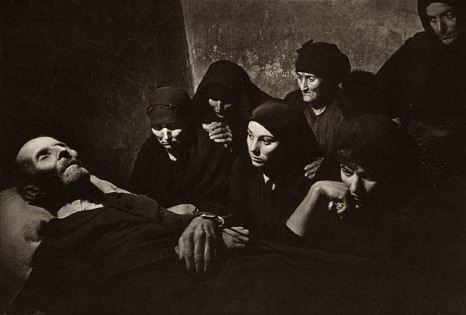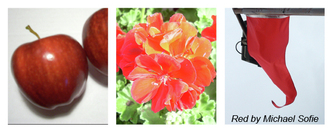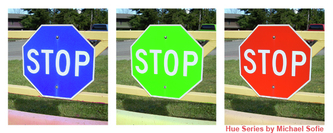Week 1- Learning to See

W. Eugene Smith- The Wake, Spanish Village
In this striking image, the light appears to emanate from a high window and is somewhat harsh. There are strong shadows on the upper left and lower right corners of this black and white photograph and they range from very dark to subtle mid tones to very light. The focus is on the mourning figure in the center, whose face is illuminated in sharp relief, however detail is evident throughout the composition. The space in the room is filled by ranks of figures from the body to the mourners nearby to the next row and to the dark figure opposite the corpse. A triangle is defined by the body, the dark figure and the dark right bottom corner. The lighter wall is a negative space and its mottled texture is clearly noted. Some of the figures clothing exhibit texture in the lines of the folds of the fabric. The pillow that the subjects head rests on also exhibits a softer texture, the only one in the room.
The picture was taken at an intimate level, framing all the participants straight on and the viewer becomes part of the scene. It is framed in such a way that everyone is packed into a small area, close to the body, except for the dark figure, who is remote and seems to embody death, as the grim reaper. The lighted central woman stands out among the other mourners, not only by the light on her face, but by her questioning expression. Four sets of hands are visible and appear to link the figures together. The repetition of their heads makes a bold line from left to right. The expressions on the faces are from serene to sorrow, from pensive to detachment. Not only are all the mourners’ heads covered, but most of their eyes are veiled. The photograph’s tones are balanced from lower left to upper right in lighter values, while upper left to lower right are dark.
The photograph is a gelatin silver print taken in 1951 and the corpse’s face and the central woman features were probably dodged to emphasize the connection between them. Also, the right bottom corner was probably burned to make it darker and mask any unnecessary detail. The figure in the top right was also darken to portray its detachment from the others.
Smith’s photograph communicates the ambiguity of death and how it impacts different emotions to individuals and relatives depending on their relationship to the person. This image is far more successful in communicating this message than it would have been in color, the depth of the blacks and brightness of the lights convey much more emotion. It is brooding, sorrowful, and at the same time, the dead person is at peace.
In this striking image, the light appears to emanate from a high window and is somewhat harsh. There are strong shadows on the upper left and lower right corners of this black and white photograph and they range from very dark to subtle mid tones to very light. The focus is on the mourning figure in the center, whose face is illuminated in sharp relief, however detail is evident throughout the composition. The space in the room is filled by ranks of figures from the body to the mourners nearby to the next row and to the dark figure opposite the corpse. A triangle is defined by the body, the dark figure and the dark right bottom corner. The lighter wall is a negative space and its mottled texture is clearly noted. Some of the figures clothing exhibit texture in the lines of the folds of the fabric. The pillow that the subjects head rests on also exhibits a softer texture, the only one in the room.
The picture was taken at an intimate level, framing all the participants straight on and the viewer becomes part of the scene. It is framed in such a way that everyone is packed into a small area, close to the body, except for the dark figure, who is remote and seems to embody death, as the grim reaper. The lighted central woman stands out among the other mourners, not only by the light on her face, but by her questioning expression. Four sets of hands are visible and appear to link the figures together. The repetition of their heads makes a bold line from left to right. The expressions on the faces are from serene to sorrow, from pensive to detachment. Not only are all the mourners’ heads covered, but most of their eyes are veiled. The photograph’s tones are balanced from lower left to upper right in lighter values, while upper left to lower right are dark.
The photograph is a gelatin silver print taken in 1951 and the corpse’s face and the central woman features were probably dodged to emphasize the connection between them. Also, the right bottom corner was probably burned to make it darker and mask any unnecessary detail. The figure in the top right was also darken to portray its detachment from the others.
Smith’s photograph communicates the ambiguity of death and how it impacts different emotions to individuals and relatives depending on their relationship to the person. This image is far more successful in communicating this message than it would have been in color, the depth of the blacks and brightness of the lights convey much more emotion. It is brooding, sorrowful, and at the same time, the dead person is at peace.






